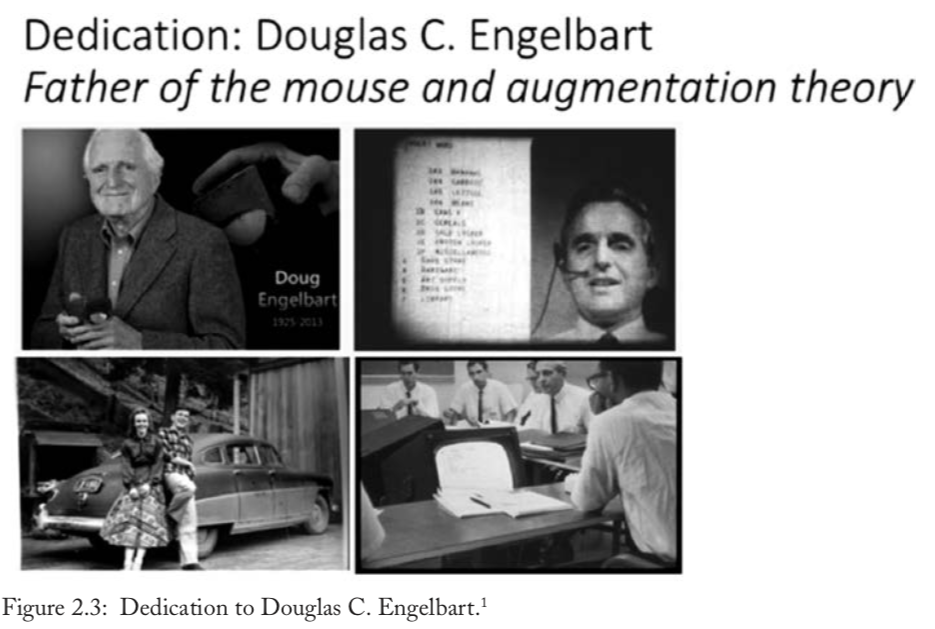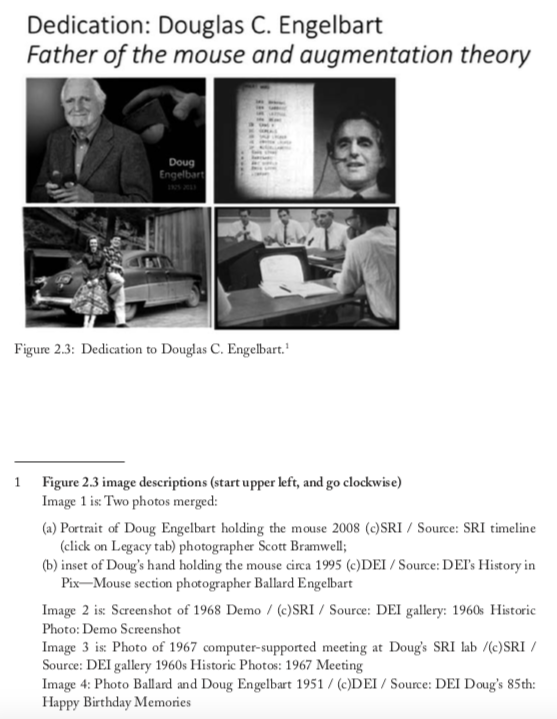Nice documentary video now available on Amazon Prime.
Today is Sunday December 9, 2018. Fifty years ago at an early computer conference in San Francisco, a researcher from SRI (Stanford Research Institute) unveiled what he and his team had created – a view of the future of augmented human performance with advanced technologies in computing and communications. Douglas C. Engelbart and team created what is famously known today as “the mother of all demos.” The text I just typed, the hyperlinks I just used, the mouse I used for positioning and clicking, and the zoom on-line meeting that I participated in last week all owe an intellectual debt to Doug and his team.
Celebrating the event is the Computer History Museum, read more here.
Reflections
In 1962, Engelbart offered a conceptual framework for augmenting human intelligence, which was the center piece of his life’s professional work (Engelbart 1962, Scanned Original). In 1968, he showed the first implementation of a rapidly evolving augmentation system that he and his team at SRI had developed (Engelbart and English 1968). In 2003, he argued that investing in “an improvement infrastructure” was still much needed while speaking to a large audience at the IBM Almaden Research Center in San Jose, CA (Engelbart 2003). In 2004, Doug and I collaborated on a paper, which was requested by colleagues from NSF (National Science Foundation), and our topic was enhancing human performance (Spohrer and Engelbart 2004). In 2017, his conceptual framework was celebrated in a book by Daniel Araya, in which I was invited to contribute a chapter (Spohrer and Siddike 2017).Last week, Nick Ragouzis emailed me, suggesting some broader connections between Engelbart’s work and several exhibits at the Computer History Museum. For example, (A) Vannevar Bush, Ted Nelson, Doug Engelbart and Hypertext exhibit, (B) Moore’s Law exhibit, and (C) Demo@50 exhibit. Without going into all the details of purple numbers, I will just say that Nick has worked hard to clarify the nature of compounding rates of improvement possible in Engelbart’s more fully implemented improvement infrastructure vision. Nick and others call this Engelbart’s Law. Improvement rates in individual silos (e.g., technology – tool systems) is limited compared to improvement rates possible with integration (e.g., tool system and human system) that overcome organizational inertia. The type of multidisciplinary thinking required for this would likely require an overhaul of the education system into a more integrated whole that considers the socio-technical system design loop (Kline 1995). So perhaps one broader area to highlight in the exhibits at the Computer History Museum Demo@50 event is emphasis on the type of education and investment frameworks required to continue to evolve Engelbart’s conceptual framework. Nick suggests some additional reading that I am eager to look at as well: (Engelbart and Engelbart 1995) and (Lienhard 1979, 1985).
Annotated Bibliography
(Engelbart 1962, Scanned Original) Engelbart DC (1962) Augmenting Human Intellect: A Conceptual Framework. Summary Report, Stanford Research Institute, on Contract AF 49(638)-1024, October 1962, 134 pages. Scanned Original, Unclassified AD 289 565, Reproduced by Armed Services Technical Information Agency, 1963 Jan 04. For annotations see below.
(Engelbart 1962, Doug Engelbart Institute Online Version) Engelbart DC (1962) Augmenting Human Intellect: A Conceptual Framework. Summary Report, Stanford Research Institute, on Contract AF 49(638)-1024, October 1962, 134 pages. Scanned Original, Unclassified AD 289 565, Reproduced by Armed Services Technical Information Agency, 1963 Jan 04. “By “augmenting human intellect” we mean increasing the capability of a man to approach a complex problem situation, to gain comprehension to suit his particular needs, and to derive solutions to problems. Increased capability in this respect is taken to mean a mixture of the following: more-rapid comprehension, better comprehension, the possibility of gaining a useful degree of comprehension in a situation that previously was too complex, speedier solutions, better solutions, and the possibility of finding solutions to problems that before seemed insoluble. And by “complex situations” we include the professional problems of diplomats, executives, social scientists, life scientists, physical scientists, attorneys, designers—whether the problem situation exists for twenty minutes or twenty years. We do not speak of isolated clever tricks that help in particular situations. We refer to a way of life in an integrated domain where hunches, cut-and-try, intangibles, and the human “feel for a situation” usefully co-exist with powerful concepts, streamlined terminology and notation, sophisticated methods, and high-powered electronic aids. Man’s population and gross product are increasing at a considerable rate, but the complexity of his problems grows still faster, and the urgency with which solutions must be found becomes steadily greater in response to the increased rate of activity and the increasingly global nature of that activity. Augmenting man’s intellect, in the sense defined above, would warrant full pursuit by an enlightened society if there could be shown a reasonable approach and some plausible benefits.” P. 1.
(Engelbart and English 1968) Engelbart DC, English WK (1968) A research center for augmenting human intellect. In Proceedings of AFIPS (American Federation of Information Processing Societies) Fall Joint Computer Conference, San Francisco, December 9-11, 1968. Pp. 395-410). “1a This paper describes a multisponsor research center at Stanford Research Institute in man-computer interaction. 1a1a For its laboratory facility, the Center has a time-sharing computer (65K, 24-bit core) with a 4.5 megabyte swapping drum and a 96 megabyte file-storage disk. This serves twelve CRT work stations simultaneously. … 1a1b1 The “mouse” is a hand-held X-Y transducer usable on any flat surface ; it is described in greater detail further on. … 1b User files are organized as hierarchical structures of data entities, each composed of arbitrary combinations of text and figures. A repertoire of coordinated service features enables a skilled user to compose, study, and modify these files with great speed and flexibility, and to have searches, analyses data manipulation, etc. executed. In particular, special sets of conventions, functions, and working methods have been developed to air [sic aid] programming, logical design, documentation, retrieval, project management, team interaction, and hard-copy production.” P.395. “2b The research objective is to develop principles and techniques for designing an “augmentation system.” … 2c The research approach is strongly empirical. At the workplace of each member of the subject group we aim to provide nearly full-time availability of a CRT work station, and then to work continuously to improve both the service available at the stations and the aggregate value derived therefrom by the group over the entire range of its roles and activities. 2d Thus the research group is also the subject group in the experiment. 2d1 Among the special activities of the group are the evolutionary development of a complex hardware-software system, the design of new task procedures for the system’s users, and careful documentation of the evolving system designs and user procedures. 2d2 The group also has the usual activities of managing its activities, keeping up with outside developments, publishing reports, etc. 2d3 Hence, the particulars of the augmentation system evolving here will reflect the nature of these tasks – i.e., the system is aimed at augmenting a system-development project team. Though the primary research goal is to develop principles of analysis and design so as to understand how to augment human capability, choosing the researchers themselves as subjects yields as valuable secondary benefit a system tailored to help develop complex computer-based systems. 2e This “bootstrap” group has the interesting (recursive) assignment of developing tools and techniques to make it more effective at carrying out its assignment. 2e1 Its tangible product is a developing augmentation system to provide increased capability for developing and studying augmentation systems. 2e2 This system can hopefully be transferred, as a whole or by pieces of concept, principle and technique, to help others develop augmentation systems for aiding many other disciplines and activities. 2f In other words we are concentrating fully upon reaching the point where we can do all of our work on line-placing in computer store all of our specifications, plans, designs, programs, documentation, reports, memos, bibliography and reference notes, etc., and doing all of our scratch work, planning, designing, debugging, etc., and a good deal of our intercommunication, via the consoles. 2f1 We are trying to maximize the coverage of our documentation, using it as a dynamic and plastic structure that we continually develop and alter to represent the current state of our evolving goals, plans, progress, knowledge, designs, procedures, and data.” P. 395-396. “4 SERVICE-SYSTEM SOFTWARE 4a The User’s Control Language 4a1 Consider the service a user gets from the computer to be in the form of discrete operations – i.e., the execution of individual “service functions” from a repertoire comprising a “service system.” 4a1a Examples of service functions are deleting a word, replacing a character, hopping to a name, etc.” P. 402.
(Engelbart 2003). Engelbart DC (2003) Improving Our Ability to Improve: A Call for Investment in a New Future. Transcription of talk and presentation at IBM Almaden Research Center’s Co-Evolution Symposium September 24 2003, organized by Jim Spohrer and Doug McDavid. “In this talk, Dr. Douglas Engelbart, who pioneered much of what we now take for granted as interactive computing, examines the forces that have shaped this growth. He argues that our criteria for investment in innovation are, in fact, short-sighted and focused on the wrong things. He proposes, instead, investment in an improvement infrastructure that can result in sustained, radical innovation capable of changing computing and expanding the kinds of problems that we can address through computing.” P. 1.
(Kline 1995) Kline SJ (1995) Conceptual foundations for multidisciplinary thinking. Stanford University Press. See summary (Campbell 2011) here.
(Spohrer and Engelbart 2004) Spohrer JC, Engelbart DC (2004) Converging technologies for enhancing human performance: Science and business perspectives. Annals of the New York Academy of Sciences. 2004 May 1;1013(1):50-82.
(Spohrer and Siddike 2017) Spohrer J, Siddike MAK (2017) Chapter 2: The Future of Digital Cognitive Systems: Tool, Assistant, Collaborator, Coach, Mediator. In Augmented Intelligence: Smart Systems and the Future of Work and Learning, Ed. Araya D. (2017 Sep 28). Peter Lang Inc., International Academic Publishers. Pp. 40-61. “Technology and organizations are two instruments that have been developed to augment the human intellect in order to make people smarter (Norman, 1993). In fact, Douglas Engelbart, an American engineer, and an early computer and Internet pioneer who invented the computer mouse, urged people to work quickly to “augment human intellect and address complex, urgent problems” (Engelbart, 1962, 1995). Herbert Simon, a Nobel Prize laureate and an American political scientist, economist, sociologist, psychologist, and computer scientist, took a mul- tidisciplinary approach to decision making and identified “bounded rationality” as a condition that technology and organizations could mitigate (Simon, 1997). Following these thinkers, we argue in this chapter that digital cognitive systems, known as cognitive mediators, may someday address a range of problems associated with “bounded rationality” (Simon, 1997), “knowledge burden” ( Jones, 2005), and “half-life-of-facts” (Arbesman, 2013).” P. 40-61.
Additional Readings:
Engelbart DC, Engelbart C (1995) “Boosting Collective
IQ: For Quantum-Leap Improvement in Productivity, Effectiveness,
Competitiveness. A New Grand Challenge”. (July 28, 1995).
Lienhard JH (1979). “The Rate of Technological Improvement
before and after the 1830s”. Technology and Culture. John’s Hopkins
Press. 20 (3): 515–530. doi:10.2307/3103814. JSTOR 3103814
Lienhard JH (1985). “Some Ideas About Growth and Quality in Technology“.
Technological Forecasting and Social Change. Elsevier: 27, 265-281
(1985)
URLs:
Celebrating… read more here: https://www.computerhistory.org/atchm/net-50-did-engelbart-s-mother-of-all-demos-launch-the-connected-world/
Douglas C. Engelbart: https://www.computerhistory.org/fellowawards/hall/douglas-c-engelbart/
(Engelbart 1962, Scanned Original) … Augmenting Human Intellect: A Conceptual Framework: https://apps.dtic.mil/dtic/tr/fulltext/u2/289565.pdf
(Engelbart 1962, Doug Engelbart Institute On-Line Version) … Augmenting Human Intellect: A Conceptual Framework: http://dougengelbart.org/content/view/138/000/
(Engelbart and English 1968) … A research center for augmenting human intellect: https://profiles.nlm.nih.gov/ps/access/BBAIKM.pdf
(Engelbart 2003) … Improving Our Ability to Improve: A Call for Investment in a New Future: http://worrydream.com/refs/Engelbart%20-%20Improving%20Our%20Ability%20to%20Improve.pdf
Engelbart’s Law: https://en.wikipedia.org/wiki/Engelbart%27s_law
(Kim 2001) An Introduction to Purple: http://eekim.com/software/purple/purple.html
(Kline 1995) … (Campbell 2011) summary here: https://prod.sandia.gov/techlib-noauth/access-control.cgi/2011/114500.pdf
(Lienhard 1985) … Some ideas about growth and quality in technology : http://www.uh.edu/engines/qualitytechnology.pdf
the mother of all demos: https://en.wikipedia.org/wiki/The_Mother_of_All_Demos


Above dedication is from book chapter by (Spohrer and Siddike 2017).